CRITCAL ANALYSIS OF COUNSELLING SESSION.
VerifiedAdded on 2022/08/17
|11
|3612
|75
AI Summary
Contribute Materials
Your contribution can guide someone’s learning journey. Share your
documents today.
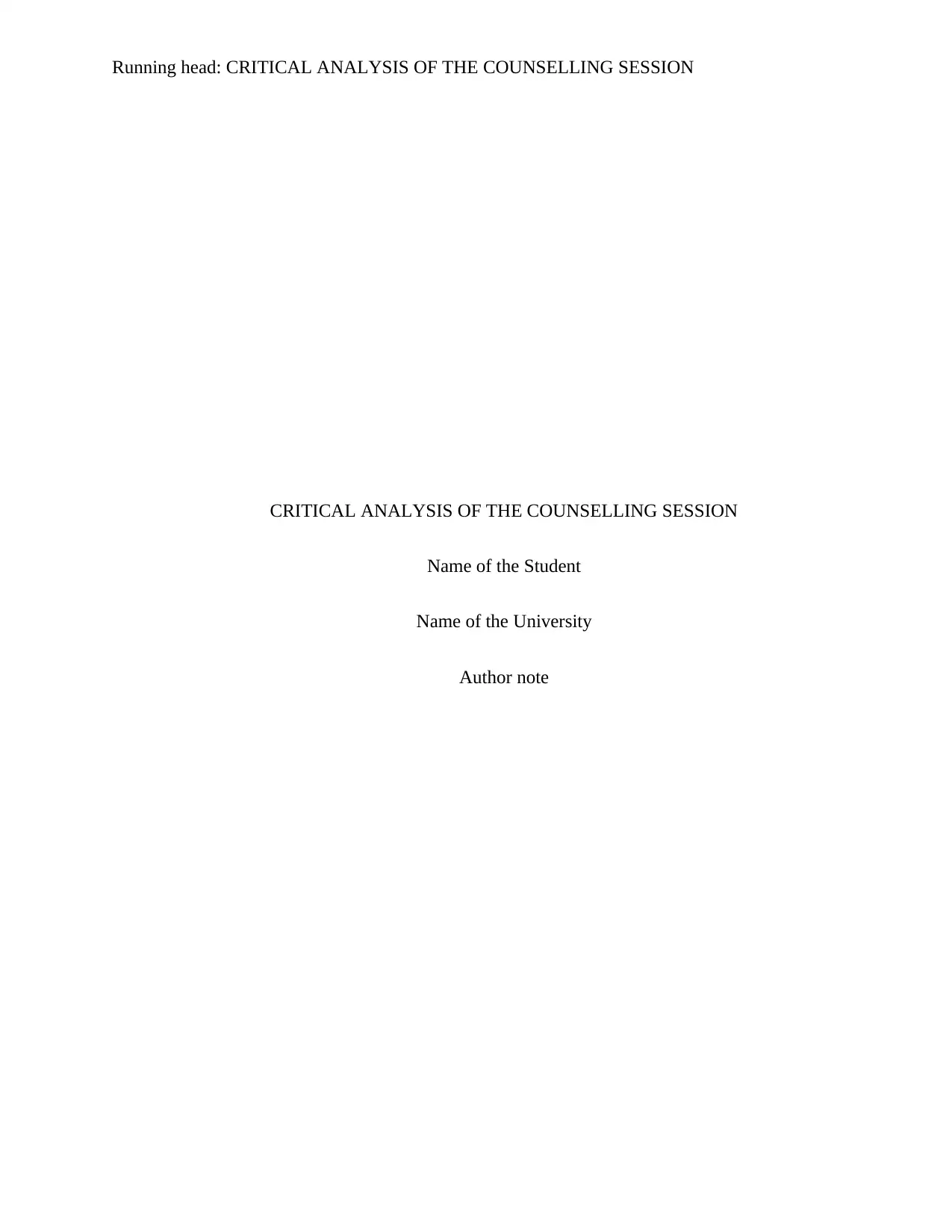
Running head: CRITICAL ANALYSIS OF THE COUNSELLING SESSION
CRITICAL ANALYSIS OF THE COUNSELLING SESSION
Name of the Student
Name of the University
Author note
CRITICAL ANALYSIS OF THE COUNSELLING SESSION
Name of the Student
Name of the University
Author note
Secure Best Marks with AI Grader
Need help grading? Try our AI Grader for instant feedback on your assignments.
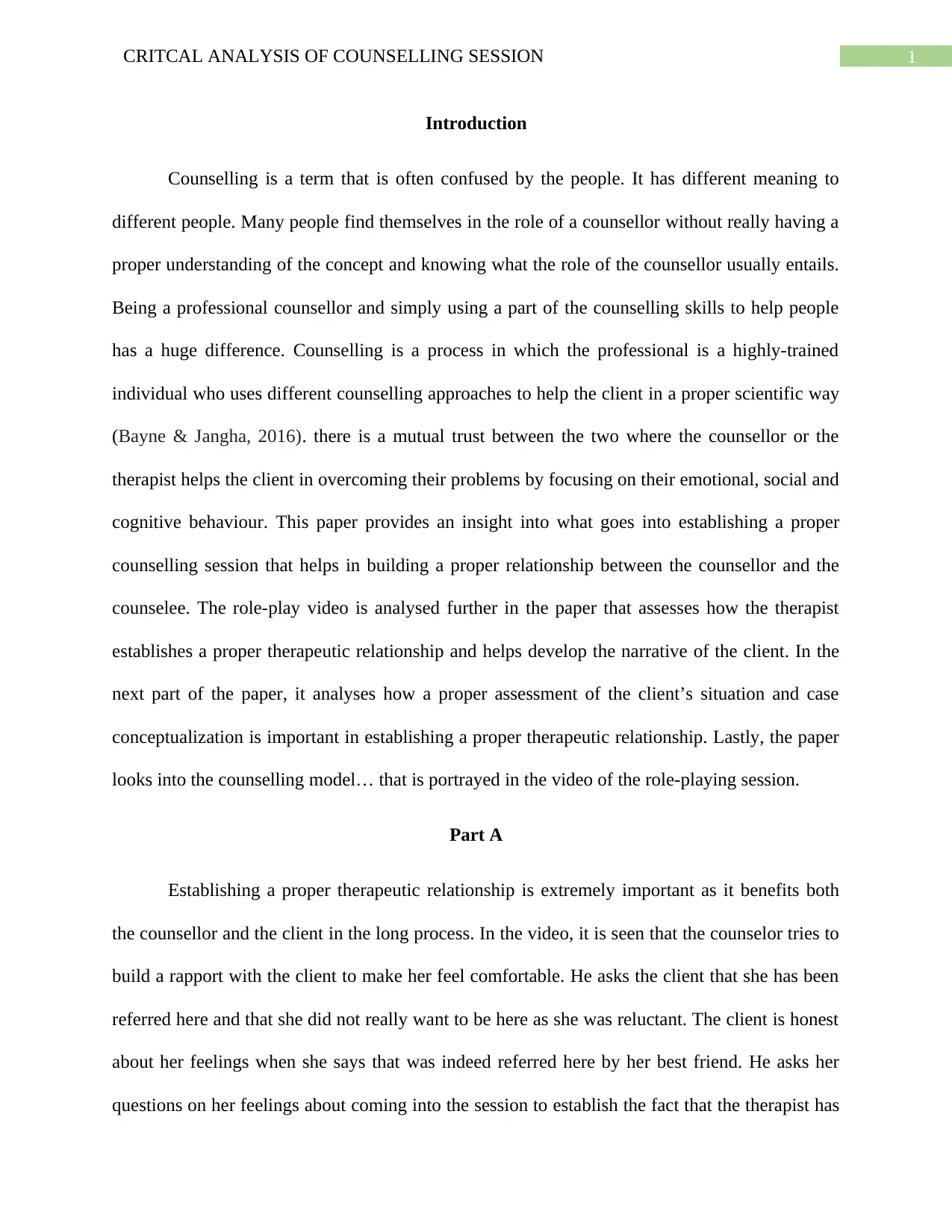
1CRITCAL ANALYSIS OF COUNSELLING SESSION
Introduction
Counselling is a term that is often confused by the people. It has different meaning to
different people. Many people find themselves in the role of a counsellor without really having a
proper understanding of the concept and knowing what the role of the counsellor usually entails.
Being a professional counsellor and simply using a part of the counselling skills to help people
has a huge difference. Counselling is a process in which the professional is a highly-trained
individual who uses different counselling approaches to help the client in a proper scientific way
(Bayne & Jangha, 2016). there is a mutual trust between the two where the counsellor or the
therapist helps the client in overcoming their problems by focusing on their emotional, social and
cognitive behaviour. This paper provides an insight into what goes into establishing a proper
counselling session that helps in building a proper relationship between the counsellor and the
counselee. The role-play video is analysed further in the paper that assesses how the therapist
establishes a proper therapeutic relationship and helps develop the narrative of the client. In the
next part of the paper, it analyses how a proper assessment of the client’s situation and case
conceptualization is important in establishing a proper therapeutic relationship. Lastly, the paper
looks into the counselling model… that is portrayed in the video of the role-playing session.
Part A
Establishing a proper therapeutic relationship is extremely important as it benefits both
the counsellor and the client in the long process. In the video, it is seen that the counselor tries to
build a rapport with the client to make her feel comfortable. He asks the client that she has been
referred here and that she did not really want to be here as she was reluctant. The client is honest
about her feelings when she says that was indeed referred here by her best friend. He asks her
questions on her feelings about coming into the session to establish the fact that the therapist has
Introduction
Counselling is a term that is often confused by the people. It has different meaning to
different people. Many people find themselves in the role of a counsellor without really having a
proper understanding of the concept and knowing what the role of the counsellor usually entails.
Being a professional counsellor and simply using a part of the counselling skills to help people
has a huge difference. Counselling is a process in which the professional is a highly-trained
individual who uses different counselling approaches to help the client in a proper scientific way
(Bayne & Jangha, 2016). there is a mutual trust between the two where the counsellor or the
therapist helps the client in overcoming their problems by focusing on their emotional, social and
cognitive behaviour. This paper provides an insight into what goes into establishing a proper
counselling session that helps in building a proper relationship between the counsellor and the
counselee. The role-play video is analysed further in the paper that assesses how the therapist
establishes a proper therapeutic relationship and helps develop the narrative of the client. In the
next part of the paper, it analyses how a proper assessment of the client’s situation and case
conceptualization is important in establishing a proper therapeutic relationship. Lastly, the paper
looks into the counselling model… that is portrayed in the video of the role-playing session.
Part A
Establishing a proper therapeutic relationship is extremely important as it benefits both
the counsellor and the client in the long process. In the video, it is seen that the counselor tries to
build a rapport with the client to make her feel comfortable. He asks the client that she has been
referred here and that she did not really want to be here as she was reluctant. The client is honest
about her feelings when she says that was indeed referred here by her best friend. He asks her
questions on her feelings about coming into the session to establish the fact that the therapist has
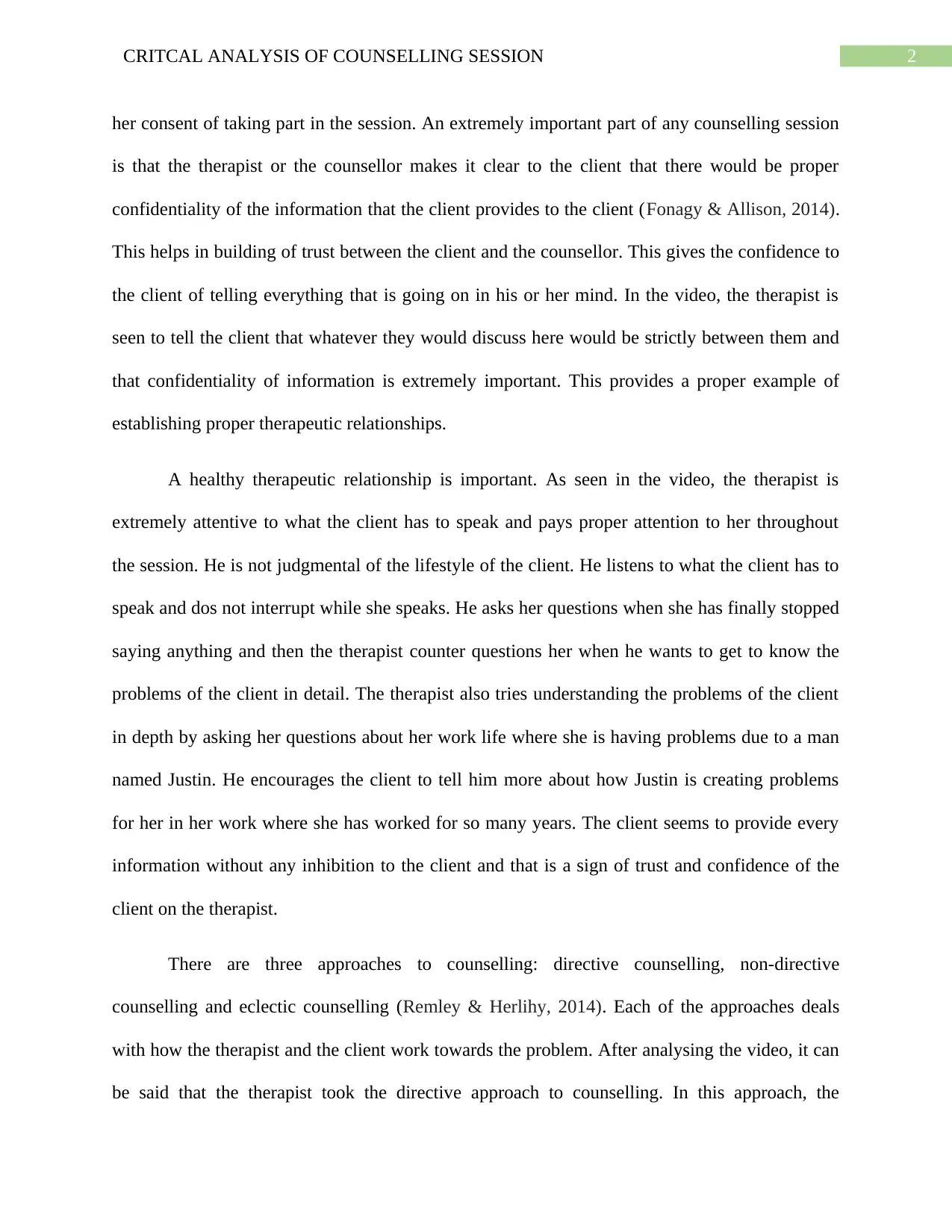
2CRITCAL ANALYSIS OF COUNSELLING SESSION
her consent of taking part in the session. An extremely important part of any counselling session
is that the therapist or the counsellor makes it clear to the client that there would be proper
confidentiality of the information that the client provides to the client (Fonagy & Allison, 2014).
This helps in building of trust between the client and the counsellor. This gives the confidence to
the client of telling everything that is going on in his or her mind. In the video, the therapist is
seen to tell the client that whatever they would discuss here would be strictly between them and
that confidentiality of information is extremely important. This provides a proper example of
establishing proper therapeutic relationships.
A healthy therapeutic relationship is important. As seen in the video, the therapist is
extremely attentive to what the client has to speak and pays proper attention to her throughout
the session. He is not judgmental of the lifestyle of the client. He listens to what the client has to
speak and dos not interrupt while she speaks. He asks her questions when she has finally stopped
saying anything and then the therapist counter questions her when he wants to get to know the
problems of the client in detail. The therapist also tries understanding the problems of the client
in depth by asking her questions about her work life where she is having problems due to a man
named Justin. He encourages the client to tell him more about how Justin is creating problems
for her in her work where she has worked for so many years. The client seems to provide every
information without any inhibition to the client and that is a sign of trust and confidence of the
client on the therapist.
There are three approaches to counselling: directive counselling, non-directive
counselling and eclectic counselling (Remley & Herlihy, 2014). Each of the approaches deals
with how the therapist and the client work towards the problem. After analysing the video, it can
be said that the therapist took the directive approach to counselling. In this approach, the
her consent of taking part in the session. An extremely important part of any counselling session
is that the therapist or the counsellor makes it clear to the client that there would be proper
confidentiality of the information that the client provides to the client (Fonagy & Allison, 2014).
This helps in building of trust between the client and the counsellor. This gives the confidence to
the client of telling everything that is going on in his or her mind. In the video, the therapist is
seen to tell the client that whatever they would discuss here would be strictly between them and
that confidentiality of information is extremely important. This provides a proper example of
establishing proper therapeutic relationships.
A healthy therapeutic relationship is important. As seen in the video, the therapist is
extremely attentive to what the client has to speak and pays proper attention to her throughout
the session. He is not judgmental of the lifestyle of the client. He listens to what the client has to
speak and dos not interrupt while she speaks. He asks her questions when she has finally stopped
saying anything and then the therapist counter questions her when he wants to get to know the
problems of the client in detail. The therapist also tries understanding the problems of the client
in depth by asking her questions about her work life where she is having problems due to a man
named Justin. He encourages the client to tell him more about how Justin is creating problems
for her in her work where she has worked for so many years. The client seems to provide every
information without any inhibition to the client and that is a sign of trust and confidence of the
client on the therapist.
There are three approaches to counselling: directive counselling, non-directive
counselling and eclectic counselling (Remley & Herlihy, 2014). Each of the approaches deals
with how the therapist and the client work towards the problem. After analysing the video, it can
be said that the therapist took the directive approach to counselling. In this approach, the
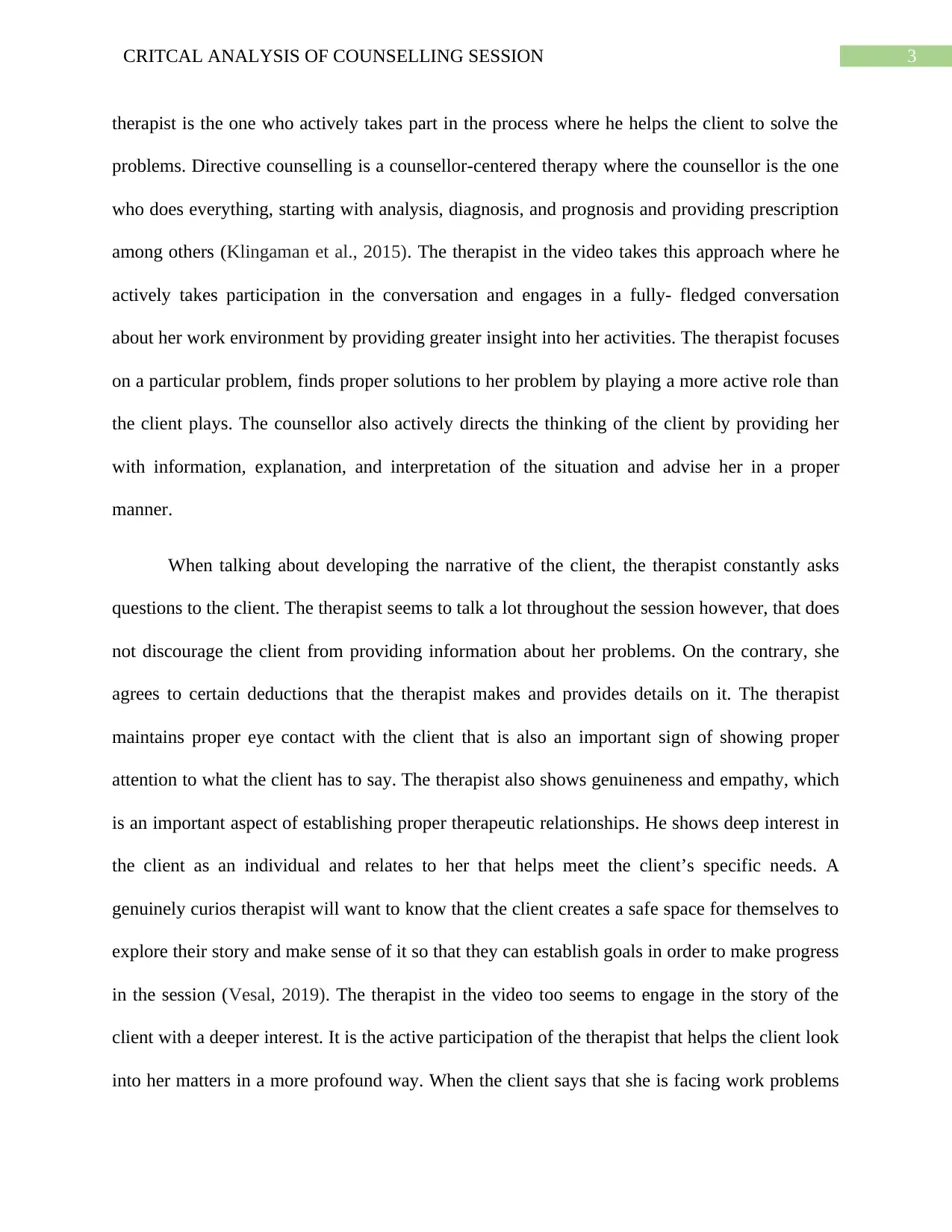
3CRITCAL ANALYSIS OF COUNSELLING SESSION
therapist is the one who actively takes part in the process where he helps the client to solve the
problems. Directive counselling is a counsellor-centered therapy where the counsellor is the one
who does everything, starting with analysis, diagnosis, and prognosis and providing prescription
among others (Klingaman et al., 2015). The therapist in the video takes this approach where he
actively takes participation in the conversation and engages in a fully- fledged conversation
about her work environment by providing greater insight into her activities. The therapist focuses
on a particular problem, finds proper solutions to her problem by playing a more active role than
the client plays. The counsellor also actively directs the thinking of the client by providing her
with information, explanation, and interpretation of the situation and advise her in a proper
manner.
When talking about developing the narrative of the client, the therapist constantly asks
questions to the client. The therapist seems to talk a lot throughout the session however, that does
not discourage the client from providing information about her problems. On the contrary, she
agrees to certain deductions that the therapist makes and provides details on it. The therapist
maintains proper eye contact with the client that is also an important sign of showing proper
attention to what the client has to say. The therapist also shows genuineness and empathy, which
is an important aspect of establishing proper therapeutic relationships. He shows deep interest in
the client as an individual and relates to her that helps meet the client’s specific needs. A
genuinely curios therapist will want to know that the client creates a safe space for themselves to
explore their story and make sense of it so that they can establish goals in order to make progress
in the session (Vesal, 2019). The therapist in the video too seems to engage in the story of the
client with a deeper interest. It is the active participation of the therapist that helps the client look
into her matters in a more profound way. When the client says that she is facing work problems
therapist is the one who actively takes part in the process where he helps the client to solve the
problems. Directive counselling is a counsellor-centered therapy where the counsellor is the one
who does everything, starting with analysis, diagnosis, and prognosis and providing prescription
among others (Klingaman et al., 2015). The therapist in the video takes this approach where he
actively takes participation in the conversation and engages in a fully- fledged conversation
about her work environment by providing greater insight into her activities. The therapist focuses
on a particular problem, finds proper solutions to her problem by playing a more active role than
the client plays. The counsellor also actively directs the thinking of the client by providing her
with information, explanation, and interpretation of the situation and advise her in a proper
manner.
When talking about developing the narrative of the client, the therapist constantly asks
questions to the client. The therapist seems to talk a lot throughout the session however, that does
not discourage the client from providing information about her problems. On the contrary, she
agrees to certain deductions that the therapist makes and provides details on it. The therapist
maintains proper eye contact with the client that is also an important sign of showing proper
attention to what the client has to say. The therapist also shows genuineness and empathy, which
is an important aspect of establishing proper therapeutic relationships. He shows deep interest in
the client as an individual and relates to her that helps meet the client’s specific needs. A
genuinely curios therapist will want to know that the client creates a safe space for themselves to
explore their story and make sense of it so that they can establish goals in order to make progress
in the session (Vesal, 2019). The therapist in the video too seems to engage in the story of the
client with a deeper interest. It is the active participation of the therapist that helps the client look
into her matters in a more profound way. When the client says that she is facing work problems
Secure Best Marks with AI Grader
Need help grading? Try our AI Grader for instant feedback on your assignments.
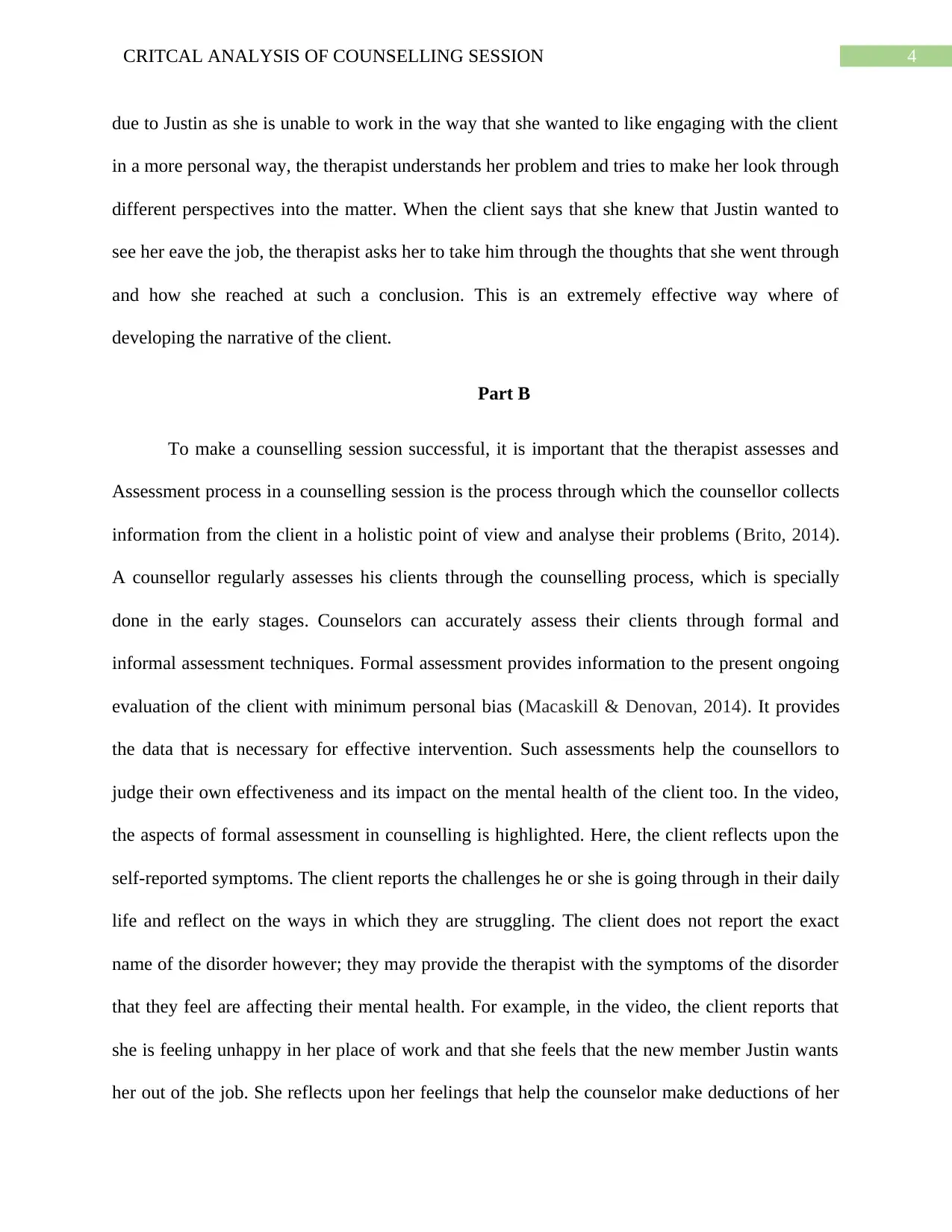
4CRITCAL ANALYSIS OF COUNSELLING SESSION
due to Justin as she is unable to work in the way that she wanted to like engaging with the client
in a more personal way, the therapist understands her problem and tries to make her look through
different perspectives into the matter. When the client says that she knew that Justin wanted to
see her eave the job, the therapist asks her to take him through the thoughts that she went through
and how she reached at such a conclusion. This is an extremely effective way where of
developing the narrative of the client.
Part B
To make a counselling session successful, it is important that the therapist assesses and
Assessment process in a counselling session is the process through which the counsellor collects
information from the client in a holistic point of view and analyse their problems (Brito, 2014).
A counsellor regularly assesses his clients through the counselling process, which is specially
done in the early stages. Counselors can accurately assess their clients through formal and
informal assessment techniques. Formal assessment provides information to the present ongoing
evaluation of the client with minimum personal bias (Macaskill & Denovan, 2014). It provides
the data that is necessary for effective intervention. Such assessments help the counsellors to
judge their own effectiveness and its impact on the mental health of the client too. In the video,
the aspects of formal assessment in counselling is highlighted. Here, the client reflects upon the
self-reported symptoms. The client reports the challenges he or she is going through in their daily
life and reflect on the ways in which they are struggling. The client does not report the exact
name of the disorder however; they may provide the therapist with the symptoms of the disorder
that they feel are affecting their mental health. For example, in the video, the client reports that
she is feeling unhappy in her place of work and that she feels that the new member Justin wants
her out of the job. She reflects upon her feelings that help the counselor make deductions of her
due to Justin as she is unable to work in the way that she wanted to like engaging with the client
in a more personal way, the therapist understands her problem and tries to make her look through
different perspectives into the matter. When the client says that she knew that Justin wanted to
see her eave the job, the therapist asks her to take him through the thoughts that she went through
and how she reached at such a conclusion. This is an extremely effective way where of
developing the narrative of the client.
Part B
To make a counselling session successful, it is important that the therapist assesses and
Assessment process in a counselling session is the process through which the counsellor collects
information from the client in a holistic point of view and analyse their problems (Brito, 2014).
A counsellor regularly assesses his clients through the counselling process, which is specially
done in the early stages. Counselors can accurately assess their clients through formal and
informal assessment techniques. Formal assessment provides information to the present ongoing
evaluation of the client with minimum personal bias (Macaskill & Denovan, 2014). It provides
the data that is necessary for effective intervention. Such assessments help the counsellors to
judge their own effectiveness and its impact on the mental health of the client too. In the video,
the aspects of formal assessment in counselling is highlighted. Here, the client reflects upon the
self-reported symptoms. The client reports the challenges he or she is going through in their daily
life and reflect on the ways in which they are struggling. The client does not report the exact
name of the disorder however; they may provide the therapist with the symptoms of the disorder
that they feel are affecting their mental health. For example, in the video, the client reports that
she is feeling unhappy in her place of work and that she feels that the new member Justin wants
her out of the job. She reflects upon her feelings that help the counselor make deductions of her
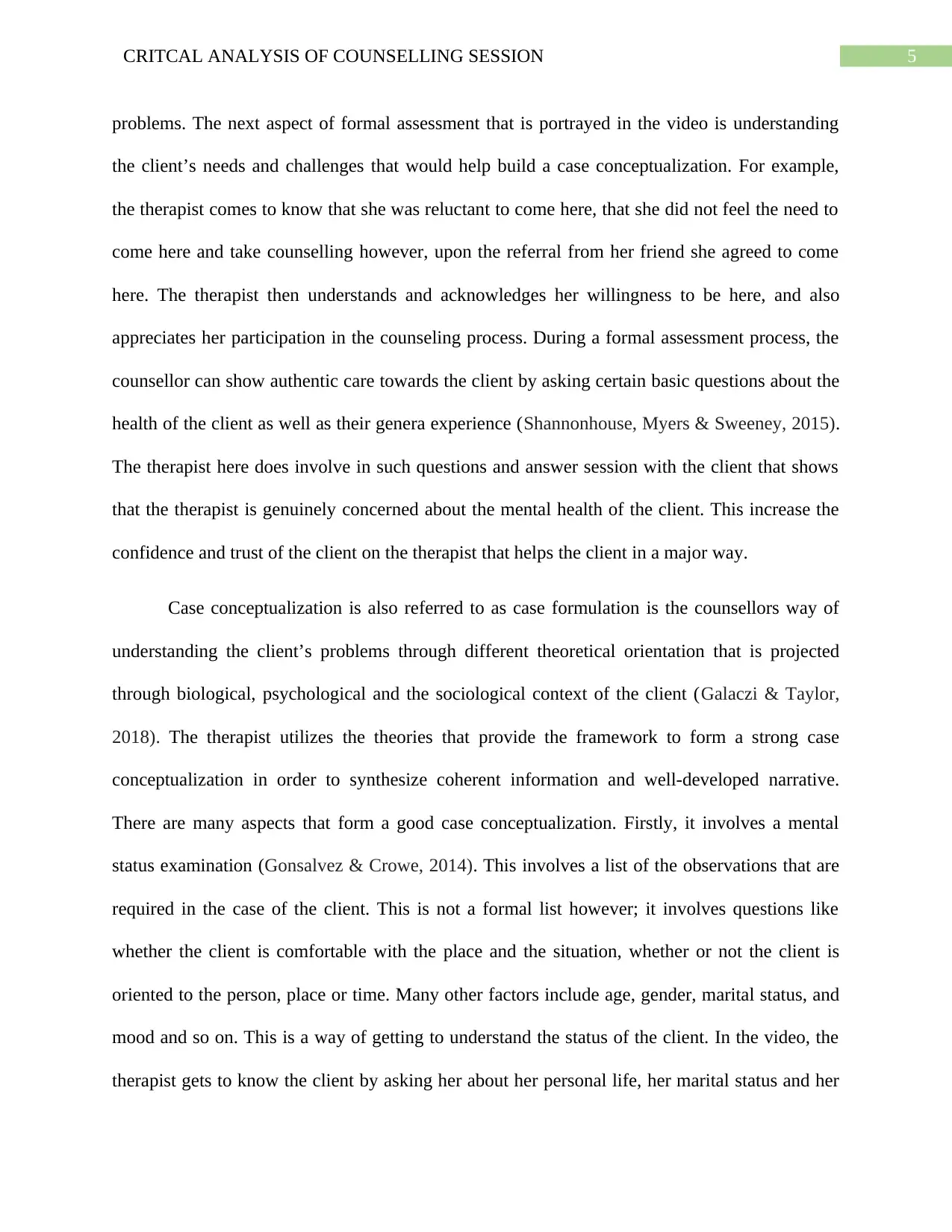
5CRITCAL ANALYSIS OF COUNSELLING SESSION
problems. The next aspect of formal assessment that is portrayed in the video is understanding
the client’s needs and challenges that would help build a case conceptualization. For example,
the therapist comes to know that she was reluctant to come here, that she did not feel the need to
come here and take counselling however, upon the referral from her friend she agreed to come
here. The therapist then understands and acknowledges her willingness to be here, and also
appreciates her participation in the counseling process. During a formal assessment process, the
counsellor can show authentic care towards the client by asking certain basic questions about the
health of the client as well as their genera experience (Shannonhouse, Myers & Sweeney, 2015).
The therapist here does involve in such questions and answer session with the client that shows
that the therapist is genuinely concerned about the mental health of the client. This increase the
confidence and trust of the client on the therapist that helps the client in a major way.
Case conceptualization is also referred to as case formulation is the counsellors way of
understanding the client’s problems through different theoretical orientation that is projected
through biological, psychological and the sociological context of the client (Galaczi & Taylor,
2018). The therapist utilizes the theories that provide the framework to form a strong case
conceptualization in order to synthesize coherent information and well-developed narrative.
There are many aspects that form a good case conceptualization. Firstly, it involves a mental
status examination (Gonsalvez & Crowe, 2014). This involves a list of the observations that are
required in the case of the client. This is not a formal list however; it involves questions like
whether the client is comfortable with the place and the situation, whether or not the client is
oriented to the person, place or time. Many other factors include age, gender, marital status, and
mood and so on. This is a way of getting to understand the status of the client. In the video, the
therapist gets to know the client by asking her about her personal life, her marital status and her
problems. The next aspect of formal assessment that is portrayed in the video is understanding
the client’s needs and challenges that would help build a case conceptualization. For example,
the therapist comes to know that she was reluctant to come here, that she did not feel the need to
come here and take counselling however, upon the referral from her friend she agreed to come
here. The therapist then understands and acknowledges her willingness to be here, and also
appreciates her participation in the counseling process. During a formal assessment process, the
counsellor can show authentic care towards the client by asking certain basic questions about the
health of the client as well as their genera experience (Shannonhouse, Myers & Sweeney, 2015).
The therapist here does involve in such questions and answer session with the client that shows
that the therapist is genuinely concerned about the mental health of the client. This increase the
confidence and trust of the client on the therapist that helps the client in a major way.
Case conceptualization is also referred to as case formulation is the counsellors way of
understanding the client’s problems through different theoretical orientation that is projected
through biological, psychological and the sociological context of the client (Galaczi & Taylor,
2018). The therapist utilizes the theories that provide the framework to form a strong case
conceptualization in order to synthesize coherent information and well-developed narrative.
There are many aspects that form a good case conceptualization. Firstly, it involves a mental
status examination (Gonsalvez & Crowe, 2014). This involves a list of the observations that are
required in the case of the client. This is not a formal list however; it involves questions like
whether the client is comfortable with the place and the situation, whether or not the client is
oriented to the person, place or time. Many other factors include age, gender, marital status, and
mood and so on. This is a way of getting to understand the status of the client. In the video, the
therapist gets to know the client by asking her about her personal life, her marital status and her
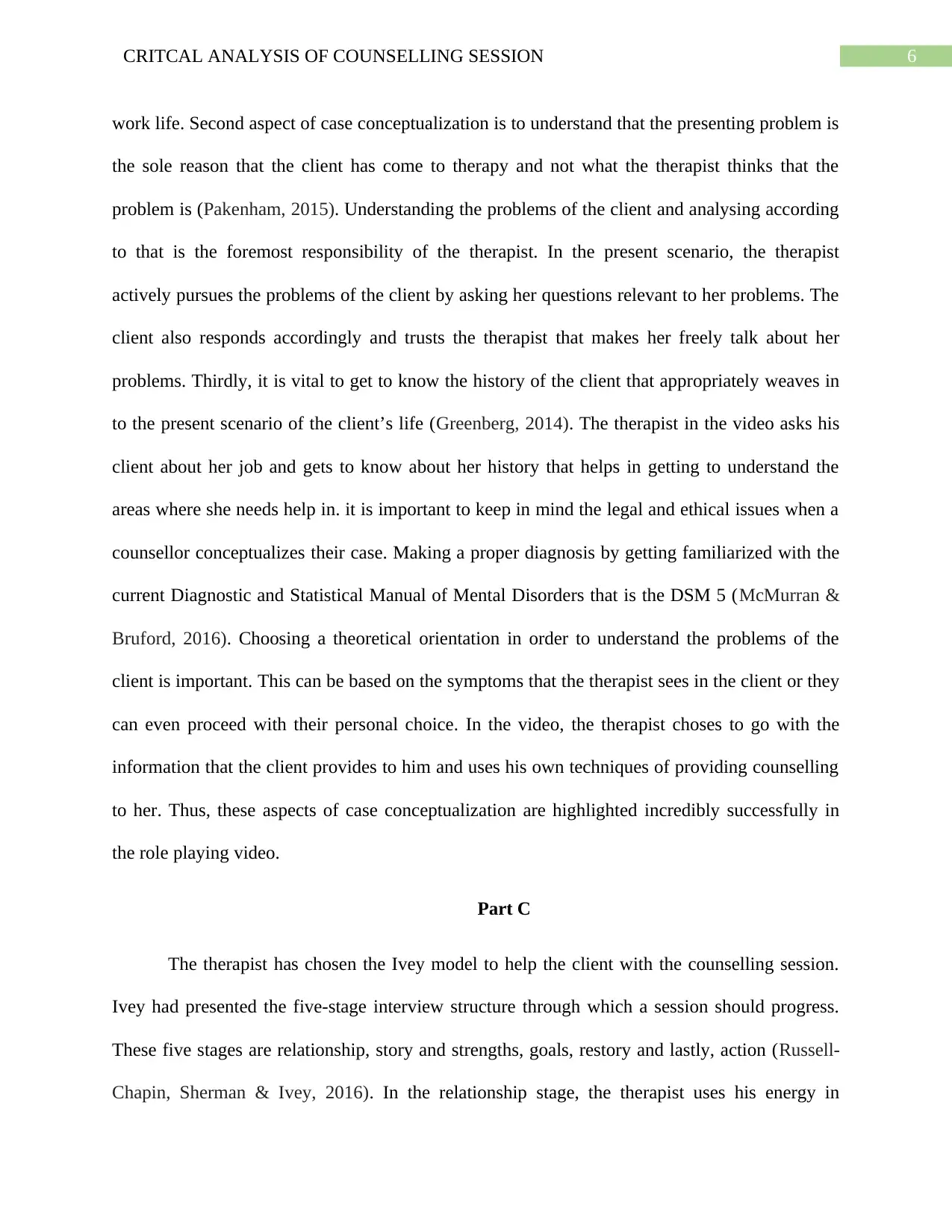
6CRITCAL ANALYSIS OF COUNSELLING SESSION
work life. Second aspect of case conceptualization is to understand that the presenting problem is
the sole reason that the client has come to therapy and not what the therapist thinks that the
problem is (Pakenham, 2015). Understanding the problems of the client and analysing according
to that is the foremost responsibility of the therapist. In the present scenario, the therapist
actively pursues the problems of the client by asking her questions relevant to her problems. The
client also responds accordingly and trusts the therapist that makes her freely talk about her
problems. Thirdly, it is vital to get to know the history of the client that appropriately weaves in
to the present scenario of the client’s life (Greenberg, 2014). The therapist in the video asks his
client about her job and gets to know about her history that helps in getting to understand the
areas where she needs help in. it is important to keep in mind the legal and ethical issues when a
counsellor conceptualizes their case. Making a proper diagnosis by getting familiarized with the
current Diagnostic and Statistical Manual of Mental Disorders that is the DSM 5 (McMurran &
Bruford, 2016). Choosing a theoretical orientation in order to understand the problems of the
client is important. This can be based on the symptoms that the therapist sees in the client or they
can even proceed with their personal choice. In the video, the therapist choses to go with the
information that the client provides to him and uses his own techniques of providing counselling
to her. Thus, these aspects of case conceptualization are highlighted incredibly successfully in
the role playing video.
Part C
The therapist has chosen the Ivey model to help the client with the counselling session.
Ivey had presented the five-stage interview structure through which a session should progress.
These five stages are relationship, story and strengths, goals, restory and lastly, action (Russell-
Chapin, Sherman & Ivey, 2016). In the relationship stage, the therapist uses his energy in
work life. Second aspect of case conceptualization is to understand that the presenting problem is
the sole reason that the client has come to therapy and not what the therapist thinks that the
problem is (Pakenham, 2015). Understanding the problems of the client and analysing according
to that is the foremost responsibility of the therapist. In the present scenario, the therapist
actively pursues the problems of the client by asking her questions relevant to her problems. The
client also responds accordingly and trusts the therapist that makes her freely talk about her
problems. Thirdly, it is vital to get to know the history of the client that appropriately weaves in
to the present scenario of the client’s life (Greenberg, 2014). The therapist in the video asks his
client about her job and gets to know about her history that helps in getting to understand the
areas where she needs help in. it is important to keep in mind the legal and ethical issues when a
counsellor conceptualizes their case. Making a proper diagnosis by getting familiarized with the
current Diagnostic and Statistical Manual of Mental Disorders that is the DSM 5 (McMurran &
Bruford, 2016). Choosing a theoretical orientation in order to understand the problems of the
client is important. This can be based on the symptoms that the therapist sees in the client or they
can even proceed with their personal choice. In the video, the therapist choses to go with the
information that the client provides to him and uses his own techniques of providing counselling
to her. Thus, these aspects of case conceptualization are highlighted incredibly successfully in
the role playing video.
Part C
The therapist has chosen the Ivey model to help the client with the counselling session.
Ivey had presented the five-stage interview structure through which a session should progress.
These five stages are relationship, story and strengths, goals, restory and lastly, action (Russell-
Chapin, Sherman & Ivey, 2016). In the relationship stage, the therapist uses his energy in
Paraphrase This Document
Need a fresh take? Get an instant paraphrase of this document with our AI Paraphraser

7CRITCAL ANALYSIS OF COUNSELLING SESSION
initiating a relationship between himself and the client (Destler, 2017). This is done by building
rapport and establishing a feeling of trust between the two. In the video, it is seen that the
therapist successfully builds a rapport with the client and gives her the assurance of
confidentiality of information between them. The client agrees with the therapist and that is a
sign that the therapist has been successful in building trust. The second stage is story and
strengths. Here the therapist encourages the client to share their information and experiences
with them, to share their problems and have a brainstorming session of ideas that can help the
therapist to better understand the situation of the client (Guterman, 2014). In the present
scenario, the therapist asks questions, gets to know the information from his client about her
work problems and provides greater insight into her situation. He constantly asks about her
feelings about her work situation and encourages the client to open up and look at the situation
through different perspectives. The third stage of the model is goals. Here the counselor and the
counselee both mutually set goals for the client to overcome the problems. Formulation of ideas
and understanding the outcome of the situation is an important aspect of this model. Here too, the
therapist and the client mutually agree on a specific goal that focuses on the client to understand
the perspective of Justin too in this case. To see past her problems and to focus on the larger goal
is vital for a good mental health of the client. The fourth stage is restory. In this stage, the
therapist helps the client to reframe his or her story and then formulate ideas and alternatives
using the client’s strengths. In the video too, it is seen that the therapist helps the client to
restructure her story that gives the client a new perspective to look at her story. She understands
the perspective of Justin too and takes into account his problems that makes her realize that he is
not actually the person to be blamed for her problems in work. The last stage is the action stage.
This stage involves the client to apply the conversation that he or she had with her therapist into
initiating a relationship between himself and the client (Destler, 2017). This is done by building
rapport and establishing a feeling of trust between the two. In the video, it is seen that the
therapist successfully builds a rapport with the client and gives her the assurance of
confidentiality of information between them. The client agrees with the therapist and that is a
sign that the therapist has been successful in building trust. The second stage is story and
strengths. Here the therapist encourages the client to share their information and experiences
with them, to share their problems and have a brainstorming session of ideas that can help the
therapist to better understand the situation of the client (Guterman, 2014). In the present
scenario, the therapist asks questions, gets to know the information from his client about her
work problems and provides greater insight into her situation. He constantly asks about her
feelings about her work situation and encourages the client to open up and look at the situation
through different perspectives. The third stage of the model is goals. Here the counselor and the
counselee both mutually set goals for the client to overcome the problems. Formulation of ideas
and understanding the outcome of the situation is an important aspect of this model. Here too, the
therapist and the client mutually agree on a specific goal that focuses on the client to understand
the perspective of Justin too in this case. To see past her problems and to focus on the larger goal
is vital for a good mental health of the client. The fourth stage is restory. In this stage, the
therapist helps the client to reframe his or her story and then formulate ideas and alternatives
using the client’s strengths. In the video too, it is seen that the therapist helps the client to
restructure her story that gives the client a new perspective to look at her story. She understands
the perspective of Justin too and takes into account his problems that makes her realize that he is
not actually the person to be blamed for her problems in work. The last stage is the action stage.
This stage involves the client to apply the conversation that he or she had with her therapist into
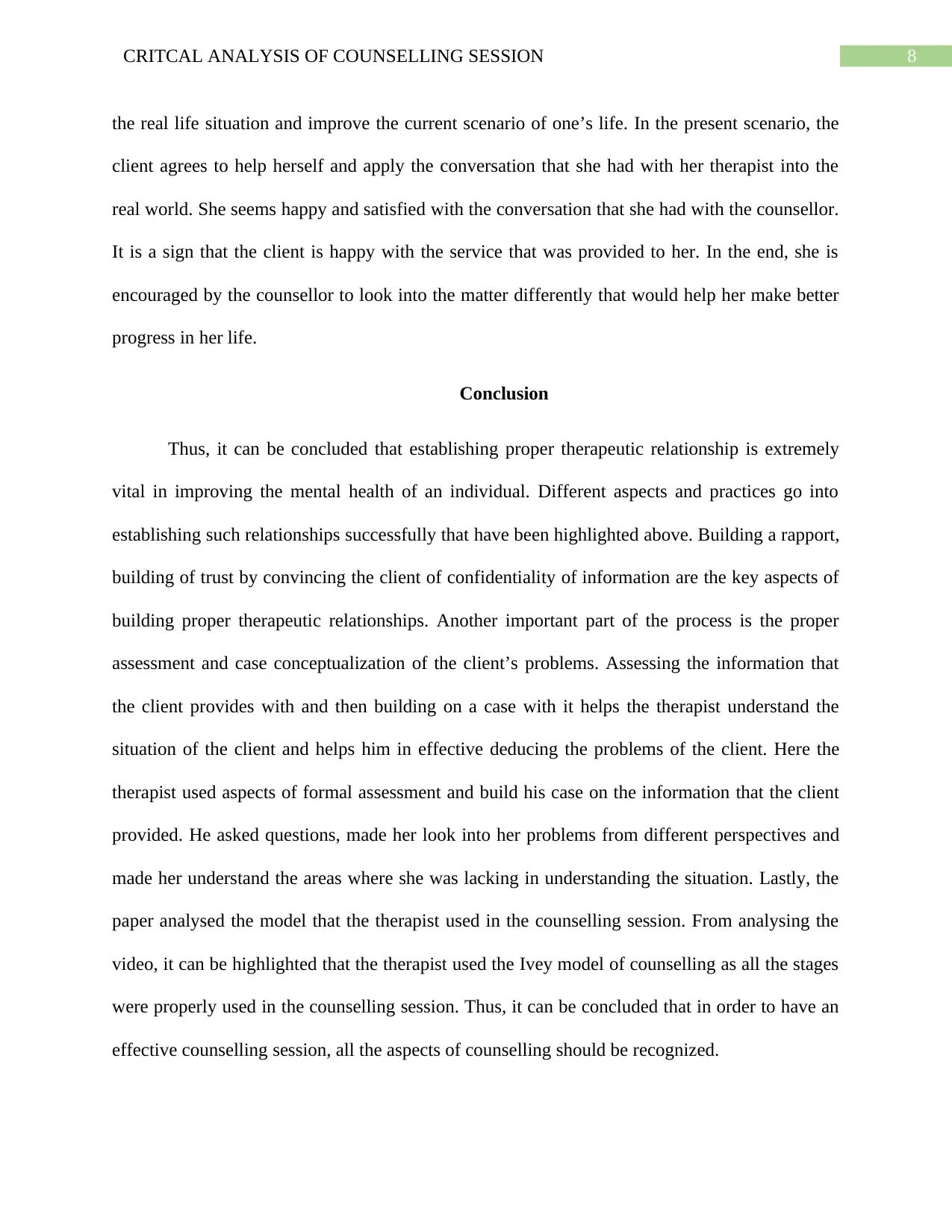
8CRITCAL ANALYSIS OF COUNSELLING SESSION
the real life situation and improve the current scenario of one’s life. In the present scenario, the
client agrees to help herself and apply the conversation that she had with her therapist into the
real world. She seems happy and satisfied with the conversation that she had with the counsellor.
It is a sign that the client is happy with the service that was provided to her. In the end, she is
encouraged by the counsellor to look into the matter differently that would help her make better
progress in her life.
Conclusion
Thus, it can be concluded that establishing proper therapeutic relationship is extremely
vital in improving the mental health of an individual. Different aspects and practices go into
establishing such relationships successfully that have been highlighted above. Building a rapport,
building of trust by convincing the client of confidentiality of information are the key aspects of
building proper therapeutic relationships. Another important part of the process is the proper
assessment and case conceptualization of the client’s problems. Assessing the information that
the client provides with and then building on a case with it helps the therapist understand the
situation of the client and helps him in effective deducing the problems of the client. Here the
therapist used aspects of formal assessment and build his case on the information that the client
provided. He asked questions, made her look into her problems from different perspectives and
made her understand the areas where she was lacking in understanding the situation. Lastly, the
paper analysed the model that the therapist used in the counselling session. From analysing the
video, it can be highlighted that the therapist used the Ivey model of counselling as all the stages
were properly used in the counselling session. Thus, it can be concluded that in order to have an
effective counselling session, all the aspects of counselling should be recognized.
the real life situation and improve the current scenario of one’s life. In the present scenario, the
client agrees to help herself and apply the conversation that she had with her therapist into the
real world. She seems happy and satisfied with the conversation that she had with the counsellor.
It is a sign that the client is happy with the service that was provided to her. In the end, she is
encouraged by the counsellor to look into the matter differently that would help her make better
progress in her life.
Conclusion
Thus, it can be concluded that establishing proper therapeutic relationship is extremely
vital in improving the mental health of an individual. Different aspects and practices go into
establishing such relationships successfully that have been highlighted above. Building a rapport,
building of trust by convincing the client of confidentiality of information are the key aspects of
building proper therapeutic relationships. Another important part of the process is the proper
assessment and case conceptualization of the client’s problems. Assessing the information that
the client provides with and then building on a case with it helps the therapist understand the
situation of the client and helps him in effective deducing the problems of the client. Here the
therapist used aspects of formal assessment and build his case on the information that the client
provided. He asked questions, made her look into her problems from different perspectives and
made her understand the areas where she was lacking in understanding the situation. Lastly, the
paper analysed the model that the therapist used in the counselling session. From analysing the
video, it can be highlighted that the therapist used the Ivey model of counselling as all the stages
were properly used in the counselling session. Thus, it can be concluded that in order to have an
effective counselling session, all the aspects of counselling should be recognized.
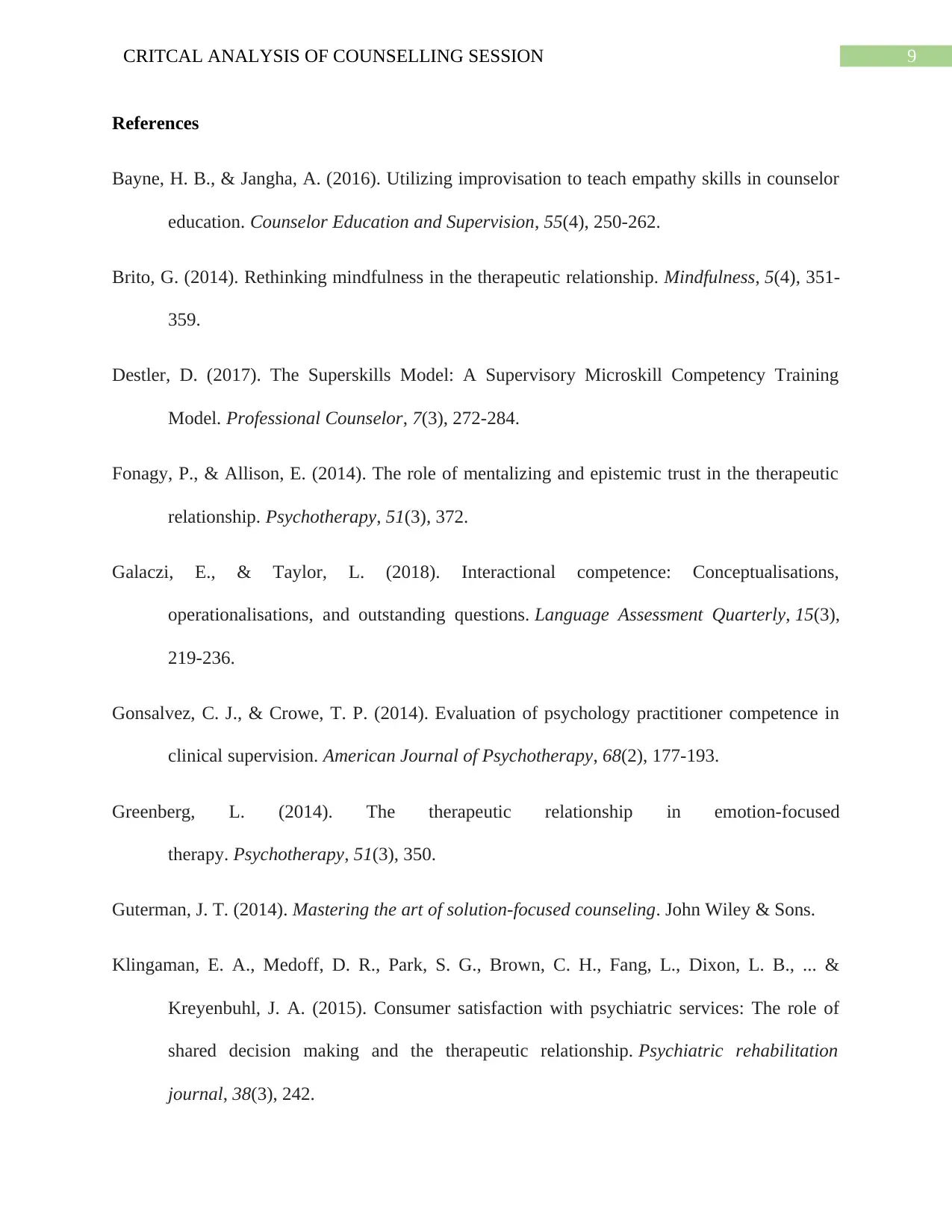
9CRITCAL ANALYSIS OF COUNSELLING SESSION
References
Bayne, H. B., & Jangha, A. (2016). Utilizing improvisation to teach empathy skills in counselor
education. Counselor Education and Supervision, 55(4), 250-262.
Brito, G. (2014). Rethinking mindfulness in the therapeutic relationship. Mindfulness, 5(4), 351-
359.
Destler, D. (2017). The Superskills Model: A Supervisory Microskill Competency Training
Model. Professional Counselor, 7(3), 272-284.
Fonagy, P., & Allison, E. (2014). The role of mentalizing and epistemic trust in the therapeutic
relationship. Psychotherapy, 51(3), 372.
Galaczi, E., & Taylor, L. (2018). Interactional competence: Conceptualisations,
operationalisations, and outstanding questions. Language Assessment Quarterly, 15(3),
219-236.
Gonsalvez, C. J., & Crowe, T. P. (2014). Evaluation of psychology practitioner competence in
clinical supervision. American Journal of Psychotherapy, 68(2), 177-193.
Greenberg, L. (2014). The therapeutic relationship in emotion-focused
therapy. Psychotherapy, 51(3), 350.
Guterman, J. T. (2014). Mastering the art of solution-focused counseling. John Wiley & Sons.
Klingaman, E. A., Medoff, D. R., Park, S. G., Brown, C. H., Fang, L., Dixon, L. B., ... &
Kreyenbuhl, J. A. (2015). Consumer satisfaction with psychiatric services: The role of
shared decision making and the therapeutic relationship. Psychiatric rehabilitation
journal, 38(3), 242.
References
Bayne, H. B., & Jangha, A. (2016). Utilizing improvisation to teach empathy skills in counselor
education. Counselor Education and Supervision, 55(4), 250-262.
Brito, G. (2014). Rethinking mindfulness in the therapeutic relationship. Mindfulness, 5(4), 351-
359.
Destler, D. (2017). The Superskills Model: A Supervisory Microskill Competency Training
Model. Professional Counselor, 7(3), 272-284.
Fonagy, P., & Allison, E. (2014). The role of mentalizing and epistemic trust in the therapeutic
relationship. Psychotherapy, 51(3), 372.
Galaczi, E., & Taylor, L. (2018). Interactional competence: Conceptualisations,
operationalisations, and outstanding questions. Language Assessment Quarterly, 15(3),
219-236.
Gonsalvez, C. J., & Crowe, T. P. (2014). Evaluation of psychology practitioner competence in
clinical supervision. American Journal of Psychotherapy, 68(2), 177-193.
Greenberg, L. (2014). The therapeutic relationship in emotion-focused
therapy. Psychotherapy, 51(3), 350.
Guterman, J. T. (2014). Mastering the art of solution-focused counseling. John Wiley & Sons.
Klingaman, E. A., Medoff, D. R., Park, S. G., Brown, C. H., Fang, L., Dixon, L. B., ... &
Kreyenbuhl, J. A. (2015). Consumer satisfaction with psychiatric services: The role of
shared decision making and the therapeutic relationship. Psychiatric rehabilitation
journal, 38(3), 242.
Secure Best Marks with AI Grader
Need help grading? Try our AI Grader for instant feedback on your assignments.

10CRITCAL ANALYSIS OF COUNSELLING SESSION
Macaskill, A., & Denovan, A. (2014). Assessing psychological health: The contribution of
psychological strengths. British Journal of Guidance & Counselling, 42(3), 320-337.
McMurran, M., & Bruford, S. (2016). Case formulation quality checklist: a revision based upon
clinicians' views. Journal of Forensic Practice.
Pakenham, K. I. (2015). Effects of acceptance and commitment therapy (ACT) training on
clinical psychology trainee stress, therapist skills and attributes, and ACT
processes. Clinical psychology & psychotherapy, 22(6), 647-655.
Remley, T. P., & Herlihy, B. (2014). Ethical, legal, and professional issues in counseling. Upper
Saddle River, NJ: Pearson.
Russell-Chapin, L. A., Sherman, N. E., & Ivey, A. E. (2016). Counseling Research Outcomes:
Discovering What Works. In Your Supervised Practicum and Internship (pp. 227-244).
Routledge.
Shannonhouse, L., Myers, J. E., & Sweeney, T. J. (2015). Counseling for wellness. Professional
counselor’s desk reference, 617-623.
Vesal, M. (2019). Professional Ethics in the Field of Psychology and Counseling (take a look at
Client’s Confidentiality and Privacy). Medical Ethics Journal, 13(44), 1-19.
Macaskill, A., & Denovan, A. (2014). Assessing psychological health: The contribution of
psychological strengths. British Journal of Guidance & Counselling, 42(3), 320-337.
McMurran, M., & Bruford, S. (2016). Case formulation quality checklist: a revision based upon
clinicians' views. Journal of Forensic Practice.
Pakenham, K. I. (2015). Effects of acceptance and commitment therapy (ACT) training on
clinical psychology trainee stress, therapist skills and attributes, and ACT
processes. Clinical psychology & psychotherapy, 22(6), 647-655.
Remley, T. P., & Herlihy, B. (2014). Ethical, legal, and professional issues in counseling. Upper
Saddle River, NJ: Pearson.
Russell-Chapin, L. A., Sherman, N. E., & Ivey, A. E. (2016). Counseling Research Outcomes:
Discovering What Works. In Your Supervised Practicum and Internship (pp. 227-244).
Routledge.
Shannonhouse, L., Myers, J. E., & Sweeney, T. J. (2015). Counseling for wellness. Professional
counselor’s desk reference, 617-623.
Vesal, M. (2019). Professional Ethics in the Field of Psychology and Counseling (take a look at
Client’s Confidentiality and Privacy). Medical Ethics Journal, 13(44), 1-19.
1 out of 11
Related Documents
Your All-in-One AI-Powered Toolkit for Academic Success.
+13062052269
info@desklib.com
Available 24*7 on WhatsApp / Email
![[object Object]](/_next/static/media/star-bottom.7253800d.svg)
Unlock your academic potential
© 2024 | Zucol Services PVT LTD | All rights reserved.





